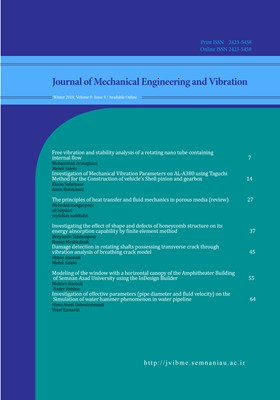The Journal of Vibration and Mechanical Engineering (JVIBME) is an independent journal devoted to the prompt publication of original papers, both theoretical and experimental, that provide new information on any aspect of Mechanic and vibration. There is an emphasis on fundamental work that has potential for practical application.
JVIBME was founded and operates on the premise that the subject of Mechanic and vibration requires a journal that publishes papers of a high technical standard across the various subdisciplines, thus facilitating awareness of techniques and discoveries in one area that may be applicable in others.
JVIBME categories
A. Active and adaptive control of sound and vibration: Analysis, design, smart structures and materials
B. Passive control of sound and vibration: Damping processes, design optimization, meta-materials,
materials for optimum damping
C. Measurement techniques and hardware; transducers with sound/vibration as input or as output
D. Inverse problems in acoustics and vibration (linear); techniques for source or system identification;
statistical methods
E. Engineering sources of noise and vibration (including combustion, high-speed flow, aeroacoustic or
aeroelastic instabilities, and fluid machinery)
F. Structural vibration/elastic wave propagation (including fluid-loaded structures, piezoelectric materials,
and granular media); Numerical modelling or physical experiments; dynamics of nano-systems*
G. Acoustics/vibroacoustics (including sound propagation in the atmosphere and ocean, structure-acoustic
coupling, flow ducts, and porous materials): Numerical modelling or physical experiments
H. High-frequency approximations for wave propagation or multimode system response: Ray methods, SEA,
power flow, semiclassical refinements; probabilistic descriptions of complex systems
I. Nonlinear aspects of sound and vibration; dynamical systems applications; perturbation methods;
nonlinear impact dynamics, damage, fatigue and transient loads**
J. Analytical methods and modeling for linear vibration and acoustics; benchmark solutions
K. Signal processing for sound and vibration applications, including source/system identification and active
control; data reduction and filtering
L. Speech intelligibility and architectural acoustics
M. Human and biologically-related issues in sound and vibration, including human and human-induced vibrations,
effects of sound and vibration on, or caused by, other living organisms. In all cases submissions should address the
physics of the phenomena through appropriately advanced theoretical approaches or by experimental investigations.
Submissions based on experimental work should give new insight into the physics of the system dynamics, for
example by including comparison with predictions from models or numerical simulations.
N. Multiphysics


